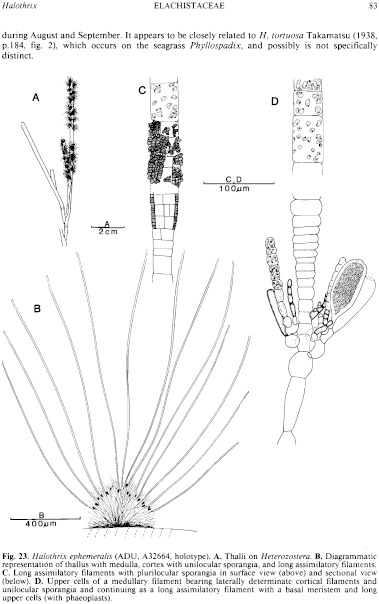|
|
|
|
|
|||||||||||
|
Electronic Flora of South Australia Species Fact Sheet
Phylum Phaeophyta – Order Chordariales – Family Elachistaceae
Thallus (Fig. 23A) medium brown, loosely tufted, 5–15 mm high, epiphytic on Heterozostera, usually with very numerous plants covering the leaves. Basal layer (Fig. 23B) of entangled filaments 6–10 µm in diameter with cells L/B 1–2. Medullary filaments (Fig. 23B) subdichotomous, 150–200 µm long, of 5–8 cells, tapering below, compact, cells subglobose to ovoid, 20–30 µm in diameter. Determinate cortical filaments (Fig. 23D) straight, 150–300 µm long, with 10–25 (–30) cells, cylindrical below to subglobose above, 12–20 µm in diameter and L/B (0.5–) 1–1.5, with intercalary divisions. Long assimilatory filaments (Fig. 23B,D) several times as long as the rest of the thallus, expanding above their meristematic base to (25–) 30–45 (–70) µm in diameter with cylindrical cells L/B 0.5–1 below, 1–2 above, each with numerous discoid phaeoplasts (Fig. 23C,D) with 1–3 small pyrenoids.
Reproduction: Plurilocular sporangia (Fig. 23C) in intercalary sori formed by anticlinal then periclinal divisions in rows of 2–8 (–20) mid to upper cells (then 40–60 µm in diameter) of the long assimilatory filaments, on plants with or without unilocular sporangia. Unilocular sporangia (Fig. 23D) more frequent than plurilocular sporangia, formed laterally below the meristem of long assimilatory filaments or from the base of determinate cortical filaments, pyriform to clavate or ovoid, 35–70 (–80) µm long and 15–30 µm in diameter.
Type from Aldinga reef, S. Aust., in shallow pools (Womersley, 29.viii.1968); holotype in ADU, A32664.
Distribution: (All on Heterozostera). The type locality, with additional collections of Skinner, 14.ix.1977; A48249 and 48250; 15.ix.1978; ADU, A49553 and 49554. Portarlington, Port Phillip, Vic. (Clayton, 4.ix.1970; MELU, 21072; ADU, A50811). West Point, Tas., lower eulittoral ( Womersley, 3.ix.1986; ADU, A57433).
Taxonomic notes: Halothrix ephemeralis occurs at the type and other localities for only about 6 weeks during August and September. It appears to be closely related to H. tortuosa Takamatsu (1938, p.184, fig. 2), which occurs on the seagrass Phyllospadix, and possibly is not specifically distinct.
References:
SKINNER, S. (1985). Australian and New Zealand species of Elachista and Halothrix (Elachistaceae, Phaeophyta). Trans. R. Soc. S. Aust. 109, 151–160.
TAKAMATSU, M. (1938). Halothrix aus dem nordöstlichen Honshû, Japan. Saito Ho-on Kai Mus. Res. Bull. 14, 181–192, Plates 24, 25.
The Marine Benthic Flora of Southern Australia Part II complete list of references.
Publication:
Womersley, H.B.S. (14 December, 1987)
The Marine Benthic Flora of Southern Australia
Part II
©Board of the Botanic Gardens and State Herbarium, Government of South Australia
Illustration in Womersley Part II, 1997: FIG. 23.

Figure 23 enlarge
Fig. 23. Halothrix ephemeralis (ADU, A32664, holotype). A. Thalli on Heterozostera. B. Diagrammatic representation of thallus with medulla, cortex with unilocular sporangia, and long assimilatory filaments. C. Long assimilatory filaments with plurilocular sporangia in surface view (above) and sectional view (below). D. Upper cells of a medullary filament bearing laterally determinate cortical filaments and unilocular sporangia and continuing as a long assimilatory filament with a basal meristem and long upper cells (with phaeoplasts).

|
Email Contact: State Herbarium of South Australia |

|